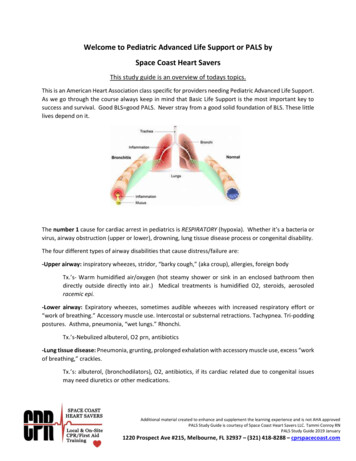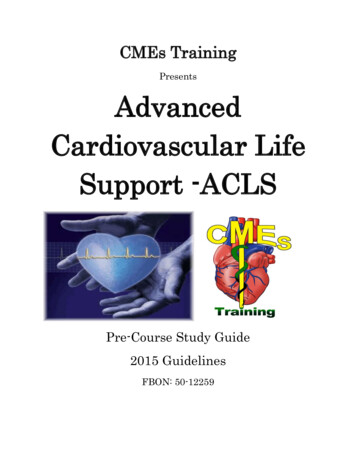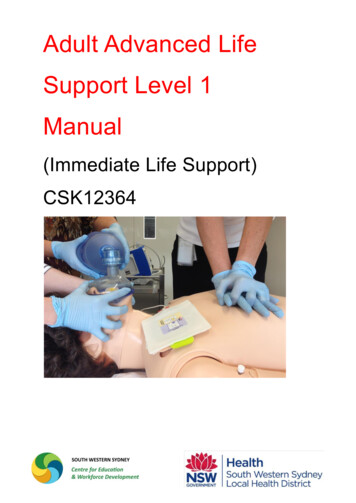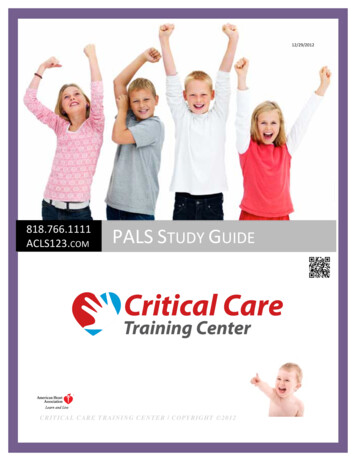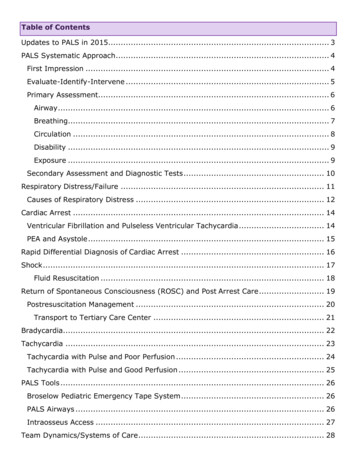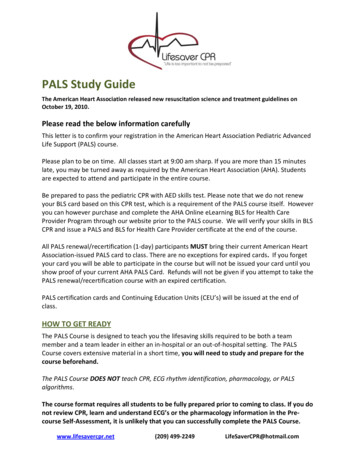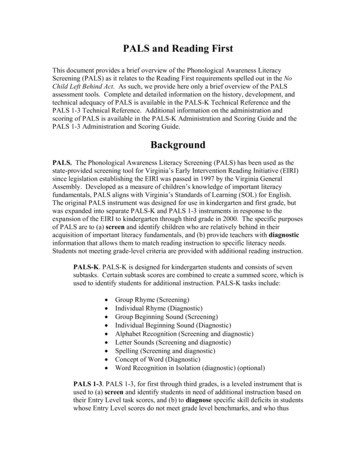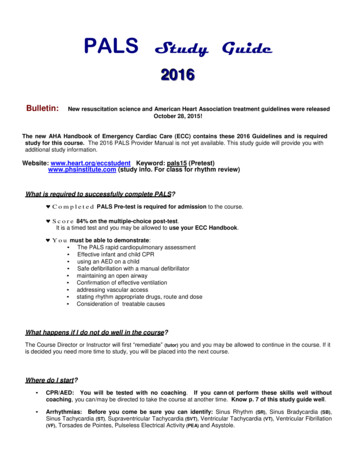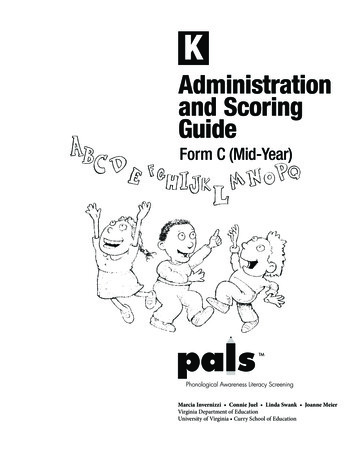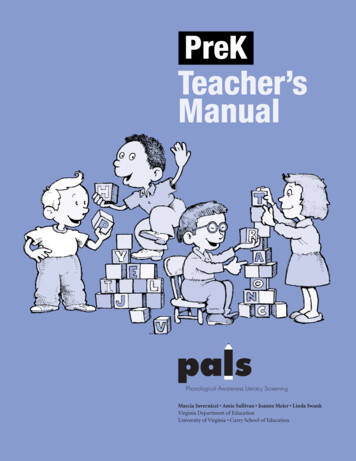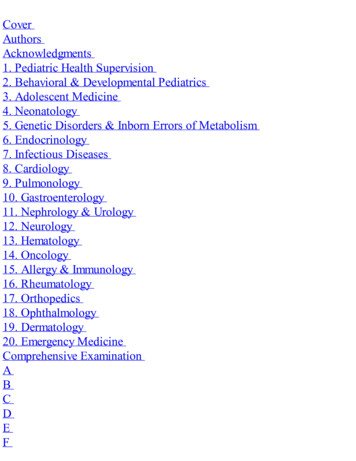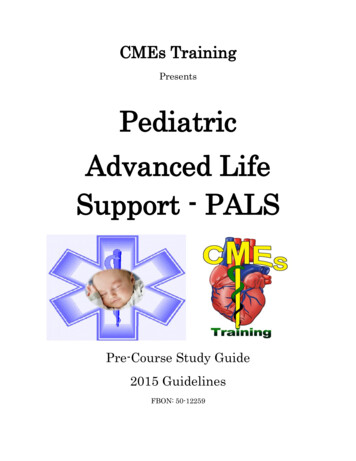
Transcription
CMEs TrainingPresentsPediatricAdvanced LifeSupport - PALSPre-Course Study Guide2015 GuidelinesFBON: 50-12259
CMEs TrainingTable of contents:Content:Page:Welcome pages3-4General information5Sample Agenda6What is PALS7- 8Pediatric ABCD9-10Airway skills11-14Electrical therapy15Vascular access16-20PALS medications21-23PALS scenarios24-30ECG review31-38PALS algorithms39-42PALS math43-45CMEs Training 11369 Okeechobee Blv. Ste. 300, Royal Palm Beach, FL. 33411 877.850.2702Page 2
CMEs TrainingThis packet is intended for use as a supplement PRIOR to attending an PediatricAdvanced Cardiac Life Support Course.Welcome to CMEs Training pre-course study packet. Critical Medical Education &Training, Inc., (CMEs Training), is committed to improving the quality ofhealthcare by providing new skills and knowledge as it becomes available throughcontinuing education. Whatever your goal – whether it be career enhancement,personal or re-licensure, CMEs Training will provide continuing education to thedisciplines it supports through Professionalism, Respect, Integrity, Dependabilityand Evaluation, (PRIDE).CMEs Training recognizes that balancing home and career can be difficult so wehave developed learning opportunities that are flexible and present themselves notonly in the traditional classroom setting but as a convenient alternative, via on-lineprograms. Additionally, we can customize any curriculum to fit the needs of yourcompany and bring it to you!Critical Medical Education & Training Incorporated is a state-of-the-art educationaland training institution committed to providing the highest level of instructionavailable for a wide variety of medical disciplines. CMEs Training offers on-lineclasses and satellite facilities in the following cities: Tampa, Jacksonville, Orlando,Washington DC, Maryland, Ohio, Virginia with additional sites being added in2017. In addition to the above facilities CMEs Training will provide instruction atmedical institutions, fire training facilities and private businesses.CMEs Training is approved by the American Heart Association, Florida Board ofNursing and Florida Department of Emergency Medicine to offer a wide variety ofcourses to fit almost any medical educational need.CMEs Training 11369 Okeechobee Blv. Ste. 300, Royal Palm Beach, FL. 33411 877.850.2702Page 3
CMEs Training instructors come to us with very diversified backgrounds within themedical and fire rescue community and have extensive experience educatingmedical professionals from a variety of disciplines. All are fully licensed andAmerican Heart Association compliant, have attained a high level of respectprofessionally, many with twenty to over thirty years of experience in theirrespective disciplines and have received professional recognition and awards priorto becoming instructors at CMEs Training.The AHA has set the GOLD STANDARDS FOR RESUSCITATION GUIDELINESAND continues to lead the field in Emergency Cardiac RESUSCITATION for allmedical professionals.The AHA recognizes only those institutions that can provide the required initial andrecertification courses as mandated by the AHA.CMEs Training provides these Gold Standards of Resuscitation guideline courses ina format that is stress-free, flexible to the needs of the student and with the latestpower point and visual teaching aids. CEUs are no longer available forrecertification of BLS, ACLS or PALS.Thank you for choosing CMEs Training for your educational needs. NOW LET’SGET STARTED!CMEs Training 11369 Okeechobee Blv. Ste. 300, Royal Palm Beach, FL. 33411 877.850.2702Page 4
CMEs TrainingPALS Study GuidePre Course Study Material for you to reviewGuidelines have recently changed and certain American Heart Association (AHA)textbooks, materials and handbooks are available now at our bookstore. Please check withyour educator to library AHA textbooks or order materials by calling Channing Bete at 1800-611-6083 or visit channingbete.com or Laerdal Medical at 877-523-7325 or laerdal.comTHE 2015 PRE-COURSE EXAM IS LOCATED ON-LINE AT www.heart.org/eccstudentEnter Pass Code: pals15AHA requires a minimum score of 70%At the end of this course you must be able to demonstrate treatment of the followingobjectives during a simulated VF (Ventricular Fibrillation), VT (Ventricular Tachycardia)and PEA (Pulseless Electrical Activity) cardiac, respiratory, or shock arrest scenario:Key changes in pediatric advanced life support, reflecting the new science from the 2010American Heart Association Guidelines for Cardiopulmonary Resuscitation and EmergencyCardiovascular Care:1- and 2-rescuer child CPR and AED use1- and 2-rescuer infant CPRManagement of respiratory emergenciesRhythm disturbances and electrical therapyVascular accessResuscitation team conceptCardiac, respiratory and shock case discussions and simulationsSystematic Approach to Pediatric AssessmentWhat happens if I do not do well in this course?The Course Director or Lead Instructor will “remediate” (tutor) you and upon remediationyou will be permitted to continue with the course.Any questions please contact our office at:877-850-2702 or 772-345-7522or online atwww.CMEsTraining.comCMEs Training 11369 Okeechobee Blv. Ste. 300, Royal Palm Beach, FL. 33411 877.850.2702Page 5
PALS Sample Initial Course AgendaApproximately 14 hoursDay 1: Registration Welcome; introduction Video introduction:o PALS Course Overviewo Overview of PALS Science Practical sessionso Respiratory Emergencieso BLS and competency testing Practical sessionso Rhythm Disturbances/Electrical Therapyo Vascular access Lunch Resuscitation Team Concept Overview of Pediatric Assessment Overview of Learning Stations Practical sessionso Respiratory Cases 1 and 2o Respiratory Cases 3 and 4o Shock Cases 5 and 6Day 2: Q&A Practical stationo Shock Cases 7 and 8o Cardiac Cases 9 and 10o Cardiac Cases 11 and 12 Putting it all together Lunch Course Summary and Testing Details Written evaluations (testing) PALS Core Case Testing Course evaluation/remediation Distribution of cardsCMEs Training 11369 Okeechobee Blv. Ste. 300, Royal Palm Beach, FL. 33411 877.850.2702Page 6
CMEs TrainingWhat is PALS?This classroom, video-based, Instructor-led course uses a series of simulated pediatricemergencies to reinforce the important concepts of a systematic approach to pediatricassessment, basic life support, PALS treatment algorithms, effective resuscitation andteam dynamics. The goal of the PALS Course is to improve the quality of care provided toseriously ill or injured children, resulting in improved outcomesThe PALS Course is for healthcare providers who respond to emergencies in infants andchildren. These include personnel in emergency response, emergency medicine, intensivecare and critical care units such as physicians, nurses, paramedics and others who need aPALS course completion card for job or other requirements.During the course you will actively participate in a series of simulated core cases.These simulations are designed to reinforce important concepts, including: Identification and treatment of problems that place the child at risk forcardiac arrest Application of a systematic approach to pediatric assessment (next page) Use of the “evaluate-identify-intervene” sequence (next page) Use of PALS algorithms and flow charts Demonstration of effective resuscitation team dynamicsFor the purposes of these guidelinesInfant BLS guidelines apply to infants approximately 1 year of age.Child BLS guidelines apply to children approximately 1 year of age untilpuberty. For teaching purposes puberty is defined as breast development infemales and the presence of axillary hair in males.CMEs Training 11369 Okeechobee Blv. Ste. 300, Royal Palm Beach, FL. 33411 877.850.2702Page 7
PALS Systematic Approach AlgorithmInitial Impression(consciousness, breathing, color)Is child unresponsive with no breathing or only gasping?YesNoShout for help/Activate EmergencyResponse(as appropriate for setting)YesIs there a pulse?Open airway and begin ventilationand oxygen is availableNoStart CPRYesIs the pulse 60/min with poor perfusiondespite oxygenation and ventilation?No(C-A-B)If you identify cardiac arrestGo toPediatric CardiacArrest AlgorithmAfter ROSC, beginEvaluate-Identify-Intervenesequence (right column) EvaluatePrimary assessmentSecondary assessmentDiagnostic testsInterveneIdentifyCMEs Training 11369 Okeechobee Blv. Ste. 300, Royal Palm Beach, FL. 33411 877.850.2702Page 8
CMEs TrainingABCD’s of pediatricsAirway:Open and hold with head tilt-chin lift (assess for effectiveness)Breathing: present or absent?Is the rate normal or too slow or too fast?Is the pattern regular or irregular or gasping?Is the depth normal or shallow or deep?Is there nasal flaring or sternal retractions or accessory muscle use?Is there stridor or grunting or wheezing?Pediatric Respiratory RatesAgeInfantToddlerPreschoolerSchool-aged childRate30-6024-4022-3418-30Circulation: Is central pulse present or absent?Is the rate normal or too slow or too fast?Is the rhythm regular or irregular?Is the QRS narrow or wide?Pediatric Heart RatesAge 3 months3 months – 2 years2-10 years10 yearsSleepingAwake80756050205190140100IS CPR NEEDED?Defibrillation:For pediatric patients defibrillation will be delivered @ 2j/kg followed by 4j/kg witha maximum of 10j/kg for Ventricular Fibrillation and Pulseless VentricularTachycardia. Pads may be placed anterior/posteriorCMEs Training 11369 Okeechobee Blv. Ste. 300, Royal Palm Beach, FL. 33411 877.850.2702Page 9
Chest compressions/Circulation check a pulsePatientRateRatioAdult100 compressionsper minute100 compressionsper minute30:2ChildInfantAt least 100compressions perminute30:2 for onerescuer (5cycles) and 15:2two rescuer (10cycles)30:2 for onerescuer (5cycles) and 15:2for two rescuer(10 cycles)Depth ofCompression2 inches or 5 cm2 inches/ 5 cm or1/3 thecircumference ofthe chest1.5 inches/ 4 cmor 1/3 thecircumference ofthe chestIn contrast to adults, cardiac arrest in infants and children does not usually resultfrom a primary cardiac cause. More often it is the terminal result of progressiverespiratory failure or shock, also called an asphyxial arrest. Asphyxia begins with avariable period of systemic hypoxemia, hypercapnea, and acidosis, progresses tobradycardia and hypotension, and culminates with cardiac arrest.1Another mechanism of cardiac arrest, ventricular fibrillation (VF) or pulselessventricular tachycardia (VT), is the initial cardiac rhythm in approximately 5% to15% of pediatric in-hospital and out-of-hospital cardiac arrests;2,–,9 it is reported inup to 27% of pediatric in-hospital arrests at some point during the resuscitation.6The incidence of VF/pulseless VT cardiac arrest rises with age.2,4 Increasingevidence suggests that sudden unexpected death in young people can be associatedwith genetic abnormalities in myocyte ion channels resulting in abnormalities in ionflowCMEs Training 11369 Okeechobee Blv. Ste. 300, Royal Palm Beach, FL. 33411 877.850.2702Page 10
CMEs TrainingPALS Assessment/ Secondary ABCD’s:Airway: Head Tilt / Chin Lift Use Bag mask with 2 person CPRProvide each breath over 1 second eachCompressor pauses to allow the 2 breathsConsider inserting an advanced airway (see advanced airway page)Breathing: Look for visible chest rise during each breathConfirm advanced airway tube placement (see advanced airway page)Secure the airway tubeCompressor now gives 100 continuous compressions per minuteVentilator gives 8-10 breaths per minute (one every 6-8 seconds)AdultPediatricInfantBLS Airway1 breath every 5-6 1 breath every 3- 1 breath every 3seconds5 seconds5 secondsALS Airway in place1 breath every 6-8 1 breath every 3- 1 breath every 3seconds max 8-10 5 seconds5 secondsbreaths/min Circulation: Obtain vascular access with an IV (Intravenous) or IO (Intraosseous)Cannulation Give medication as recommended per algorithmDifferential Diagnosis: “Why is this patient in this rhythm?” Look for possiblecauses:6 H’s6 aHydrogen Ion (acidosis)TamponadeTension PneumothoraxToxins-poisons, drugsThrombosis-coronary (AMI) –Pulmonary(PE)CMEs Training 11369 Okeechobee Blv. Ste. 300, Royal Palm Beach, FL. 33411 877.850.2702Page 11
CMEs TrainingAirway SkillsDuring this course you will be expected to participate in manikin practice anddemonstrate proficiency in the below skills:Basic Airway: (BLS)Oxygen: To use or not to use Open the airwayo Use the head tilt – chin lift when assessing for adequate breathingo Use a jaw thrust for unresponsive, trauma or drowningo If unable to open the airway with a jaw thrust, use head tilt – chin lift Maintain the airwayo Insert an oropharyngeal airway when unconscious with no cough orgag reflexo Insert a nasopharyngeal airway when a cough or gag reflex is present(better tolerated) Ventilate Give a breath over 1 second using providing enough volume to seethe chest riseo 2 rescuer CPR: give 2 breaths during the pause following the 15compressionso Rescue breathing: when a pulse, give 10-12 breath/minute 1 every 3-5seconds **Refer back to page 11**Advanced Airway:Supraglottic Airway (Bridge Device) #1 requires the least training for insertion Inserts blindly into the hypo pharynx Regurgitation and aspiration are reduced but not prevented Confirm placement: See chest rise and listen for breath sounds over the lungfields Contraindications: gastric reflux, full stomach, pregnancy, or morbid obesityCMEs Training 11369 Okeechobee Blv. Ste. 300, Royal Palm Beach, FL. 33411 877.850.2702Page 12
Supraglottic Airway (Bridge Device) #2: requires more training for insertion thanBridge device #1 Inserts blindly into esophagus (80% of the time) or the trachea Ventilation can occur whether the tube is in the esophagus or the trachea Confirm placement: clinical exam and a confirmation device (see below)Endotracheal Tube (ETT): requires the most training, skill and frequency to retaininse
The PALS Course is for healthcare providers who respond to emergencies in infants and children. These include personnel in emergency response, emergency medicine, intensive care and critical care units such as physicians, nurses, paramedics and others who need a PALS course completion card for job or other requirements. During the course you will actively participate in a series of simulated .
